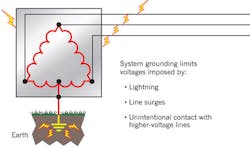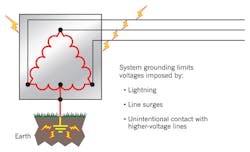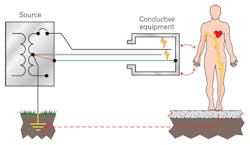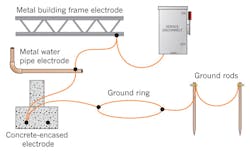High-Tech Training Methods for Learning Grounding and Bonding Basics
Few topics are more important to a safe and efficient electrical installation and more interesting to electrical workers and contractors than proper grounding and bonding. Grounding and bonding is crucial in virtually every electrical installation — from residential service to industrial facilities to sensitive electronic equipment, health-care installations, or campus-style facilities with multiple buildings. Proper installation is essential to fulfilling the functions of a successful grounding and bonding electrical design.
Overcoming the confusion
Grounding and bonding remains a mysterious topic to many in the industry. The root cause of this confusion has historically been due to two primary causes — a lack of understanding of the fundamental purposes of system grounding (Fig. 1 and Fig. 2) and misinformation on the path that ground fault current will take. Many have learned current will only take the path of least resistance; however, ground fault current will actually return to its source over any available conductive path (Fig. 3).
The truth is grounding and bonding need not be such a struggle. One way to help installers grasp and retain these concepts is to create a training curriculum that follows the installation in the same manner in which the electrical worker would install the grounding and bonding system in actual practice. Training should begin with a thorough coverage of the basics, including terminology, and then advance through all the different scenarios a learner will encounter in most workplaces. Numerous diagrams, illustrations, product images, and field photographs should be used to recreate the field installation as closely as possible. A solid foundation and understanding of the principles of grounding and bonding is essential as a resource for installers to draw on throughout his or her career in the electrical industry.
Although grounding and bonding concepts are fairly constant, it may be years between the time a learner first masters the material in the classroom and when he or she applies the principles out in the field. One way to help installers improve their long-term knowledge retention of the concepts of grounding and bonding is the use of animation and interaction via a virtual job site.
The NJATC is currently leveraging this type of technology through its Grounding and Bonding Academy, which focuses on the core concepts and principles of grounding and bonding, such as grounding electrodes, grounding electrode conductors, and grounding electrode systems. Job-site scenarios are recreated in a virtual environment to help better prepare students to be more productive and confident about their skills. For example, the student might be presented with several potential grounding electrodes. The online module provides the opportunity for him or her to examine, interact with, and determine whether individual electrodes meet the criteria that qualifies it as an electrode (Fig. 4).
A blended learning solution
Although classroom learning, coupled with on-the-job training, has served — and will continue to serve — the learner well, today’s technology has presented us with an incredible opportunity to take training to the next level. A blended learning curriculum incorporates instructor-led training with a learning management system (LMS). This approach combines the best of textbook training — incorporating illustrations and photos — with an online environment that offers enriched materials. The result is a thorough transfer of knowledge and understanding of the subject matter.
Many topics are difficult to fully understand in a two-dimensional printed book. Employing technology to add moving or animated parts helps illustrate hard-to-grasp topics like grounding and bonding. Related scenarios that incorporate animation, such as the actual fault current paths during a lightning strike, for example, enhance the learning process. This concept, which is difficult to show in a printed format, can be more easily demonstrated in an animated online medium.
One other advantage of an LMS is the unparalleled feedback it provides classroom instructors. By using this tool, teachers can obtain customized information on where each individual learner needs additional instruction — and where he or she truly comprehends the subject matter. This results in little or no additional time being spent on a topic that was understood by all.
The NJATC is excited about leveraging this type of technology to train future electrical workers and help bring the mystery of grounding and bonding back down to earth.
Hickman is a director with the NJATC based in Upper Marlboro, Md. The NJATC is the training arm of the International Brotherhood of Electrical Workers and the National Electrical Contractors Association. He can be reached at [email protected].




